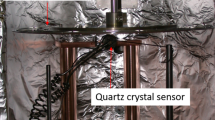Abstract
In order to explore the isospin dependence of the quasifission process, a set of reactions with a wide range of N/Z was required. To maximize the sensitivity of the measurement to the isospin effects it was required that the Z of the projectile and target be fixed. Therefore, a set of isotopic targets spanning a relatively large N/Z range was desired. Tungsten, having five stable isotopes, provided a 6 neutron difference from 180W to 186W and can be obtained with high enrichment. Therefore, the production of enriched 180,182,184,186W targets was needed. Additionally, the targets were required to be relatively thin (<100 μg/cm2) in order to minimize the energy loss and scattering of the fission or quasifission fragments resulting from the reactions. Details of the W target preparation as well as target performance will be presented.


Similar content being viewed by others
References
Armbruster P (2000) Annu Rev Nucl Part Sci 50:411
Hofmann S, Munzenberg G (2000) Rev Mod Phys 72:733
Hamilton JH, Hofmann S, Oganessian YT (2013) Annu Rev Nucl Part Sci 63:383
Zagrebaev VI, Aritomo Y, Itkis MG, Oganessian YT, Ohta M (2001) Phys Rev C 65:014607
du Rietz R et al (2013) Phys Rev C 88:054618
Back BB (1985) Phys Rev C 31:2104
Toke J et al (1985) Nucl Phys A 440:327
Berriman AC et al (2001) Nature 413:144
Oganessian YT et al (2006) Phys Rev C 74:044602
Oganessian YT et al (2012) Phys Rev Lett 109:162501
Loveland W (2007) Phys Rev C 76:014612
Kohley Z (2013) EPJ Web Conf 63:02003
Liang JF, Gross CJ, Kohley Z et al (2012) Phys Rev C 85:031601(R)
Vinodkumar AM et al (2008) Phys Rev C 78:054608
Sahm C-C et al (1985) Nucl Phys A 441:316
Lesko KT et al (1986) Phys Rev C 34:2155
Gallant JL (1972) Nucl Instr Meth 102:477
Sapir L, Rozenwasser B (1981) Proceedings of the INTDS, 99
Maier-Komor P (1974) Proceedings of the INTDS, 70
Ellsworth CE (1978) Report LBL-7950, 79
Ford JLC (1984) Report ANL/PHY-84-2, 43
Thomas GE (1984) Report ANL/PHY-84-2, 249
Maier HJ (1991) Nucl Instr Meth A303:172
Folger H, Hartmann W, Klemm J, Lommel B, Thalheimer W (1997) Nucl Instr Meth A397:55
Karasek FJ (1979) Nucl Instr Meth 167:165
Lenz WH, Peterson CE (1961) The Powder Rolling of Molybdenum and Tungsten, Los Alamos Scientific Laboratory Report LAMS-2612
Lozowski WR, Rife TM (1981) Book: Jaklovsky J (ed), Plenum Press, NY 143
Stolarz A (1997) Nucl Instr Meth A397:114
Gallant JL (1984) Report ANL/PHY-84-2, 219
Gobby PL, Barthell BL, Gomez VM, Moore JE (1991) Nucl Instr Meth A303:187
Sugai I (1997) Nucl Instr Meth A397:81
Shidling PD, Abhilash SR, Kabiraj D, Madhavan N (2008) Nucl Instr Meth A590:79
Lipski AR, Lefferts RS (2011) Nucl Instr Meth A655:41
Thomas GE et al (1991) NIM A303:162–164
Thomas GE, Greene JP (1995) NIM A362:201–204
Pawlak AS, Greene JP (2011) INTDS Newsletter 36.1, 20
Hammerton K, Kohley Z et al in preparation
Acknowledgments
This material is based upon work supported by the U.S. Department of Energy, Office of Science, Office of Nuclear Physics, under Contract No. DE-AC02-06CH11357 and by the National Science Foundation under Grant Nos. PHY-1102511 and IIA-1341088. This research used resources of ANL’s ATLAS facility, which is a DOE Office of Science User Facility.
Author information
Authors and Affiliations
Corresponding author
Additional information
The submitted manuscript has been created by UChicago Argonne, LLC, Operator of Argonne National Laboratory (“Argonne”). Argonne, a U.S. Department of Energy Office of Science laboratory, is operated under Contract No. DE-AC02-06CH11357. The U.S. Government retains for itself, and others acting on its behalf, a paid-up nonexclusive, irrevocable worldwide license in said article to reproduce, prepare derivative works, distribute copies to the public, and perform publicly and display publicly, by or on behalf of the Government.
Rights and permissions
About this article
Cite this article
Greene, J.P., Kohley, Z. Isotopic tungsten targets. J Radioanal Nucl Chem 305, 743–747 (2015). https://doi.org/10.1007/s10967-015-3977-9
Received:
Published:
Issue Date:
DOI: https://doi.org/10.1007/s10967-015-3977-9



